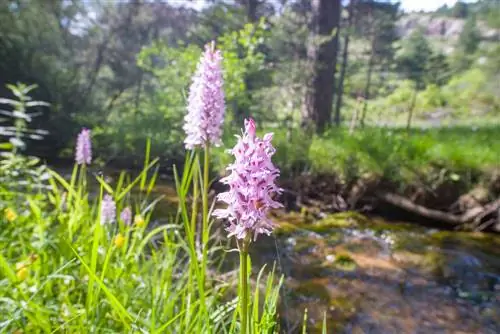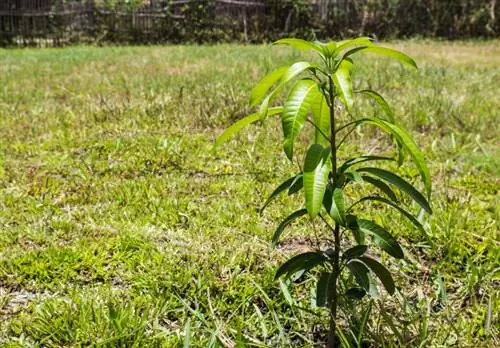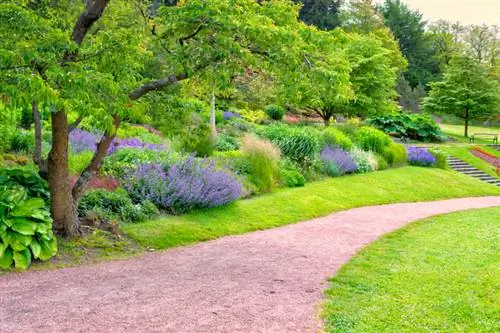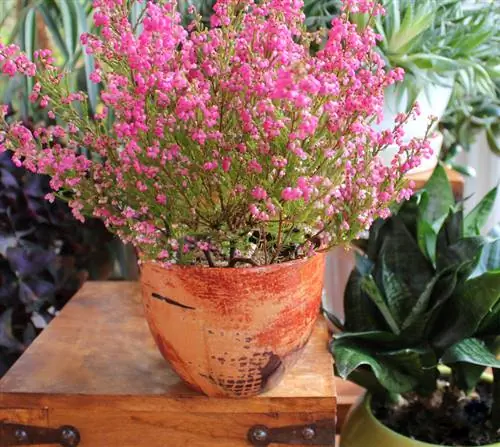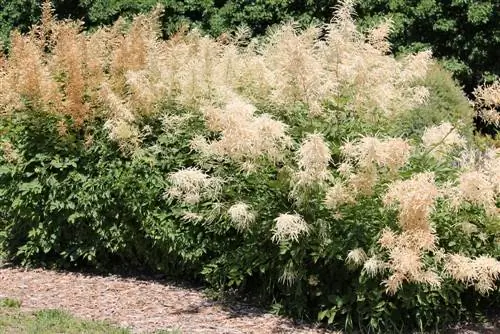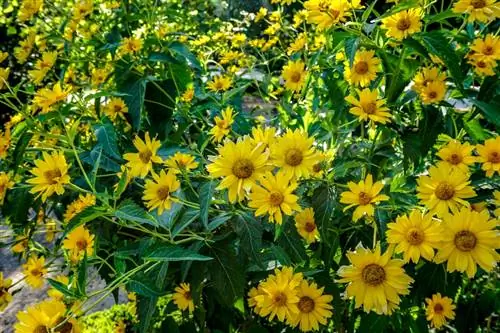- Author admin [email protected].
- Public 2023-12-16 16:46.
- Last modified 2025-06-01 06:02.
Read a commented orchid profile here with information on growth, leaves, inflorescences and three beautiful species. Lots of tips about planting and caring for Dactylorhiza as a garden orchid.
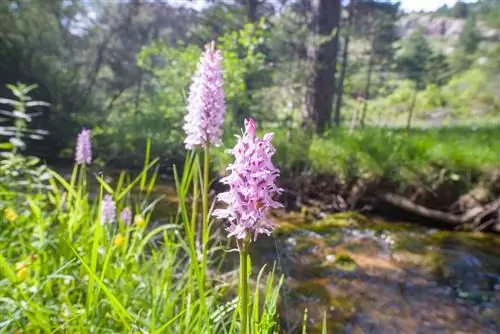
What is orchid and when does it bloom?
Orchid (Dactylorhiza) is a genus of hardy terrestrial orchids that occur in around 40 species and are native to Central Europe. They grow as perennials and have broad oval to lanceolate leaves, as well as striking flower clusters in various colors. Their main flowering time is May to August.
Profile
- Scientific name: Dactylorhiza
- Family: Orchids (Orchidaceae)
- Synonyms: fingerroot, helmet flower, cuckoo flower
- Area of distribution: Central Europe
- Growth type: perennial, terrestrial orchid
- Growth height: 15 cm to 90 cm
- Leaf: broadly oval to lanceolate
- Flower: Grape
- Fruit: Capsule
- Roots: Tubers
- Winter hardiness: hardy
- Status: highly protected, critically endangered
Growth
Orchid is the German name of the species-rich genus Dactylorhiza from the orchid family. In contrast to demanding, cold-sensitive, exotic orchid species, orchids thrive as native, hardy, hardy terrestrial orchids right on our doorstep. The main distribution area in Central Europe is Germany with more than 30 percent of the total population. The good news is: Orchids, which are threatened with extinction, also thrive in hobby gardens. All important key growth data for reading:
- Growth type: perennial, herbaceous plant as a tuberous geophyte with decorative inflorescences and distinctive leaves.
- Stem: tightly upright, pithy, hollow or filled depending on the species, often tinged with purple.
- Growth height: 15 cm to 90 cm (depending on the species).
- Roots: hand-shaped root tubers, 10 cm to 20 cm long.
- Ghorticulturally interesting properties: hardy, easy to care for, natural treasure in need of protection, decorative appearance, slightly toxic.
Orchid species
The orchid genus Dactylorhiza contains around 40 species, most of which are native to Europe. The following table introduces you to three of the most beautiful orchid species:
| Orchid species | Broad-leaved Orchid | Spotted Orchid | Fox' Orchid |
|---|---|---|---|
| Botanical name | Dactylorhiza majalis | Dactylorhiza maculata | Dactylorhiza fuchsii |
| Growth height | 15-40 cm | 20-60 cm | 20-90 cm |
| leaves | ovoid-lanceolate, darkly spotted | linear, lanceolate, round spotted | lanceolate, obovate, spotted |
| Inflorescence | conical-cylindrical | cone-shaped ear of wheat | roll-shaped |
| Flower color | purple red to dark pink | pink-white-purple | dark purple |
| Flowering time | May to August | May to August | June to July |
| Habitats | Wet meadows, riparian forests | Heather moor areas, poor meadows | Forests, wet meadows, spring bogs |
Other orchid species are extremely rare to find in the wild. These include: Flesh-colored orchid (Dactylorhiza incarnata), also known as stiff-leaved crabwort, whose light pink to flesh-colored flowers can only be admired in the foothills of the Alps and in Mecklenburg. The straw-yellow orchid (Dactylorhiza ochroleuca) inhabits wet meadows and fens, where it presents its up to 20 cm long, light yellow inflorescences. An encounter with the highly endangered Green Hollowtongue (Dactylorhiza viridis) is reserved for mountain hikers who look for the greenish flowers in alpine meadows.
Video: Lucky find on the side of the road - spotted orchid seen up close
Leaf
In early spring, characteristic leaves sprout from the overwintered root tuber with these properties:
- Leaf growth: basal, loose rosette and 2 to 8 leaves distributed on the lower stem.
- Leaf shapes: depending on the type, broad-oval, obovate, linear or lanceolate, pointed.
- Leaf size: 5 cm to 20 cm long.
- Special feature: Leaves of the basal rosette are larger than the leaves surrounding the stem.
- Leaf colors: depending on the species, light to dark green, flawless monochrome or reddish spotted.
Bloom
Above the leaves, the strong stem continues as a magnificent orchid inflorescence with these characteristics:
- Inflorescence: racemose, conical-cylindrical or cylindrical with up to 60 individual flowers.
- Single flower: 1 upright sepal (sepal), 2 lateral petals (petale) are fused together in a helmet shape over a lower lip, in the middle a 0.8 to 2 mm thick spur, straight or curved.
- Special feature: Leaf-like bracts, usually longer than the flower.
- Flower colors: pink, purple, violet, red, yellow, white, lower lip often dotted, striped or spotted.
- Pollinators: numerous species of insects, primarily hymenoptera, such as bees, bumblebees and beetles.
Interesting detail: Orchid is a clever nectar illusion flower. The terrestrial orchid blooms seductively in bright colors and, with a thick spur in the middle of each individual flower, suggests a rich nectar buffet. In fact, the empty spur is a deception for busy bees and bumblebees. Instead of feasting on the nectar, each pollinator is brazenly stuck with a packet of pollen for free transport to the next orchid flower. The second name cuckoo flower refers to this floral scrounging mentality.
Fruit
Pollinated orchid flowers turn into spindle-shaped capsule fruits. It contains 2,000 to 5,000 fine, dusty seeds that can germinate for many years. Each seed has only one cavity made of air. The lack of nutrient tissue makes orchid seeds feather-light grain flyers with a range of up to 10 kilometers. This strategy has a downside: Without nutrient tissue in their luggage, the seeds later have to rely on certain fungi for nutrient supply at the landing site so that they can even germinate.
Excursus
Orchis - namesake of all orchids
Orchis is the second domestic orchid genus with the popular name orchids. This name refers to two oval-round, testicle-like root tubers as survival organs and was quickly transferred to all orchid genera. As early as April, orchis unfold their cylindrical, lush inflorescences above a ground-level rosette of mostly unspotted leaves. In contrast to the genus Dactylorhiza (cinquefoil), Orchis prefer to inhabit habitats in forest areas that are dry in summer and moist in winter.
Planting orchid
You can buy orchid for planting in the garden from a certified specialist retailer. The Dactylorhiza species offered there come from artificial propagation and not from illegal and reprehensible removal of wild terrestrial orchids. Where and how to plant fingerroot correctly, read here:
Propagation
The easiest way for hobby gardeners to master vegetative propagation is through daughter tubers. In comparison, sowing is a difficult undertaking because the germination of orchid seeds is dependent on the presence of mycorrhizal fungi. Suitable daughter tubers of strictly protected orchids should come from a generous gardener friend or from mother plants from your own stock. The expert procedure is very simple:
- Dig up orchids in spring or after flowering.
- Cut off well-developed, rooted daughter tubers with a sharp, disinfected knife or scalpel.
- Replant and water the mother plant with at least one additional daughter tuber.
- Fill the flower pot with a mix of peat-free rhododendron soil and coconut fiber in equal parts.
- Plant the daughter tuber as deep as before and water.
- Grow orchid offshoots in a partially shaded location until autumn.
Planting time
The best time to plant orchid is in autumn from the beginning/mid of September. The native terrestrial orchid can quickly root in the sun-warmed soil and is well prepared for the upcoming winter. Have you missed the optimal planting time? Then a second time window opens in spring, when severe frosts are no longer expected in your region.
Location
These are the ideal conditions for orchids in the garden:
- Sunny to partially shaded location.
- Fresh to moist garden soil, well-drained, loose and humus.
- Ideally neutral to slightly acidic pH between 5.7 and 6.5.
- Exclusion criteria: shade, waterlogging, very calcareous, alkaline pH value greater than 7.5.
Orchid blooms and thrives most beautifully in moist to wet meadows, in bog beds or under light deciduous trees. The broad-leaved orchid (Dactylorhiza majalis) even tolerates short-term flooding as long as its roots are not permanently waterlogged.
Planting
Good soil preparation and simple protection against waterlogging are important for the perfect planting of orchid. For a garden orchid in top form, you shouldn't miss these planting tips:
- The potted orchid is placed in a bucket of rainwater before planting.
- The soil at the site is fine, loose and free of weeds, stones and old roots.
- The planting pit is large enough so that the fingered root tuber does not collide with the side edges.
- A handful of lava granules, rhododendron soil and crushed tree bark are added to the excavation.
- A thin layer of lava granules, expanded clay or sand on the bottom of the pit acts as drainage against waterlogging.
Plant the water-soaked, now potted terrestrial orchid, press the substrate firmly with both hands and water with rainwater.
Caring for Orchid
Orchid is easy to care for in the right location. A regular water supply is important. Supplemental nutrients are only given when needed. Pruning care is scheduled once a year. Winter protection is recommended in the first year of operation. The best orchid care tips to read:
Pouring
- Water orchid moderately in dry conditions without causing waterlogging.
- Indication of need for watering: Finger test detects no moisture at a depth of 1 cm to 2 cm.
- Watering water quality: use collected rainwater, skimmed pond water or decalcified tap water.
Fertilize
- Fertilize orchid with deficiency symptoms.
- Typical deficiency symptoms: pale leaves, stunted flowers, short stature.
- Fertilize cinquefoil ideally organically with horn shavings, horse manure, sifted compost soil or plant manure.
- Extra tip: Showering the root slice in autumn with potassium-rich comfrey manure strengthens winter hardiness.
Cutting
- Rule of thumb: cut orchids like other terrestrial orchids.
- Basic rule: Cutting green orchid plant parts impairs growth, vitality and flowering.
- Best time to prune: in late autumn, when all above-ground parts of the plant have died.
- Pruning: cut off retracted leaves and stems close to the ground with a knife or perennial sickle.
Wintering
A well-grown orchid can withstand bitter frost down to -20° Celsius. If temperatures fall below freezing in autumn, the plant retracts its above-ground parts. The underground, fingered root tuber overwinteres with one or more daughter tubers. The native orchid has to develop its robust winter hardiness in the first year. The young perennial is grateful for light winter protection. After pruning in autumn, cover the root disc with leaves and spruce branches.
Diseases and pests
The impressive orchid leaves are a target for various diseases. Dactylorhiza root tubers are on the menu for voracious pests. The following table provides an overview of common damage patterns, lists typical causes and gives tips for combating them:
| malicious image | Cause | Countermeasures |
|---|---|---|
| White leaf coating | Mildew | Cut off infected leaves, spray plant with milk-water solution |
| Brown-black spots | Leaf spot disease | cut off affected leaves, dust dark spots with charcoal powder |
| Rolled, stunted leaves, tiny lice underneath | Aphids | rinse vigorously, spray with soft soap solution |
| Pen feeding, stunted growth | Weevils, especially black weevils | Flower pot trap, apply heterorhabditis nematodes |
Popular varieties
In addition to our three fingerroot protagonists in the table above, orchid specialist shops have other beautiful orchid varieties to choose from:
- Elderberry cinquefoil (Dactylorhiza sambucina): impresses with light yellow flowers with dark red dots in the middle and a light elderberry scent, flowering period May to June, height 10 cm to 30 cm.
- Overlooked Orchid (Dactylorhiza praetermissa): boasts large, pink-purple inflorescences, ring-shaped mottled leaves, flowering period in May and June, height 20 cm to 70 cm.
- Male Orchid (Orchis mascula): ovate-lanceolate rosette leaves, light purple to purple flowers from April to June, height up to 70 cm.
- Purple orchid (Orchis purpurea): Orchid of the year 2013 with white, light purple flowers in May and June, height 25 cm to 80 cm.
FAQ
Which plant neighbors are suitable for broad-leaved orchid?
Broad-leaved orchid (Dactylorhiza majalis) prefers fresh, moist habitats in sunny to partially shaded locations, such as wet meadows and pond edges. There, the native terrestrial orchid maintains good neighbors with marsh marigold (C altha palustris), palm frond sedge (Carex muskingumensis) and meadowfoam (Cardamine pratensis). Picturesque contrasts arise when the white-flowering swamp forget-me-not 'Ice Pearl' (Myosotis palustris) lies at the feet of the purple-flowering fingerroot.
How does broad-leaved orchid grow?
Broad-leaved orchid (Dactylorhiza majalis) sprouts from the root tuber in spring from April and unfolds its leaves as a loose rosette. Shortly afterwards, a strong stem emerges and blooms from the beginning to mid-May. What is characteristic of the native orchid is that the lower flowers develop before the shoot has reached its final height. From July/August, the inflorescence is the first to wilt. The leaves turn yellow in autumn. Parallel to the above-ground growth, the mother tuber forms one or more daughter tubers, which sprout happily after the winter for another period of flowering. In this way, the broad-leaved orchid continues to expand over the years.
Where can Male Orchid be found?
Male orchid (Orchis mascula) is also aptly called stately orchid because it stretches up to 65 centimeters towards the sky. The 15 centimeter long inflorescence sits on a 50 centimeter high stem and boasts 30 individual purple flowers. The magnificent flower festival can be admired from the end of April on wet meadows and in sparse deciduous forests. Increasing bush cover, drainage and construction of its habitats are making life difficult for the male orchid. In 2009, Orchis mascula was named Orchid of the Year to raise awareness of the threat.
Where does the name orchid come from?
The hallmark of orchid is two spherical, testicle-like root tubers. As early as 300 BC, Greek naturalists took advantage of the striking resemblance to male genitalia to christen wild orchids with the name orchid. Only since the middle of the 20th century have terrestrial orchids been divided into the genera Orchis and Dactylorhiza. The scientific separation had no influence on the name Orchid.
What is the crossword clue for Orchid?
There are three answers to this question. Does the orchid crossword puzzle ask for a 6-letter word? Then the answer is: Orchis. However, if 9 letters have to be entered, the solution is: helmet flower. The longest answer word has 13 letters and is: cuckoo flower.
What can I do as a hobby gardener to protect orchid?
Bund Nature Conservation and NABU are very active in protecting orchids. At the top of the list is the preservation of poor and wet meadows as fundamental habitats for the endangered wild orchids. For this purpose, the volunteer conservationists purchase and maintain wet meadows with a population of orchids. As a hobby gardener close to nature, you can make a valuable contribution to this by creating a wildflower meadow in the garden with orchis and dactylorhiza. Of course, the planting material should come from trustworthy orchid gardeners. It is important to note that the meadow should not be mowed until July at the earliest so that the orchid seeds can form and spread.

